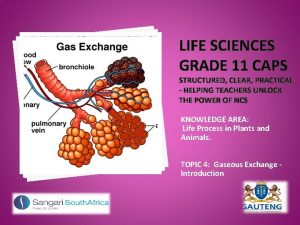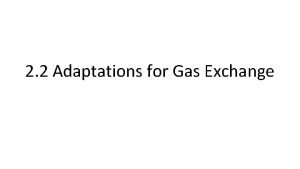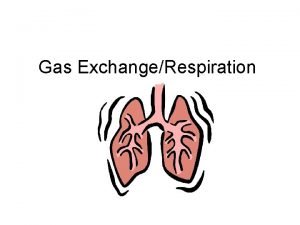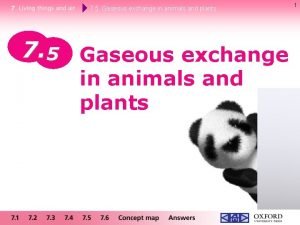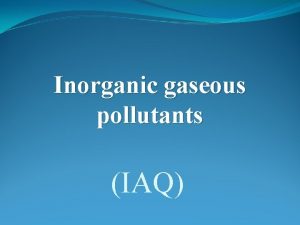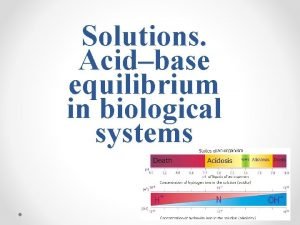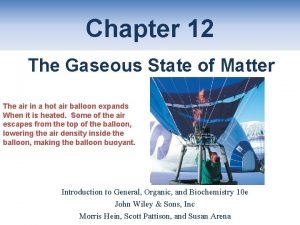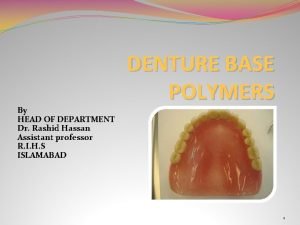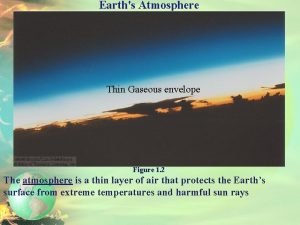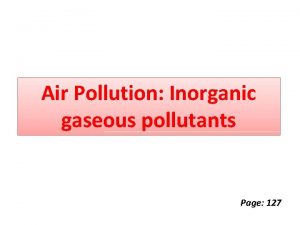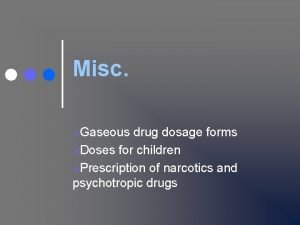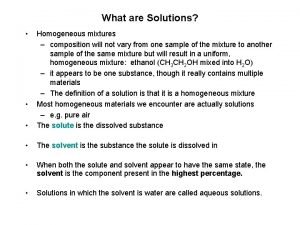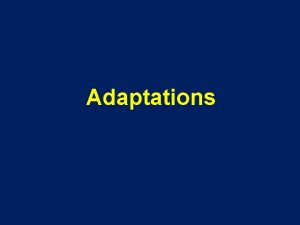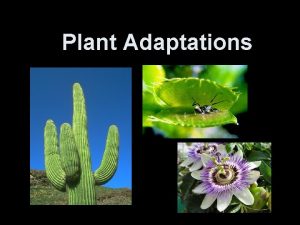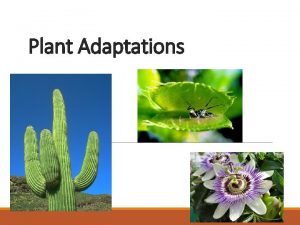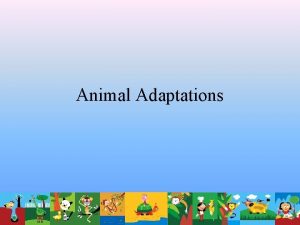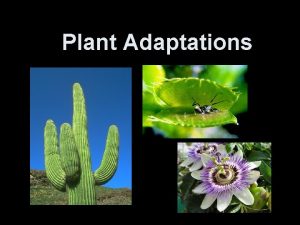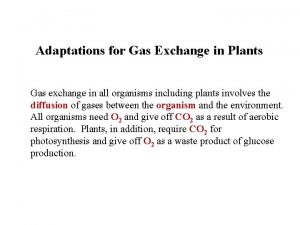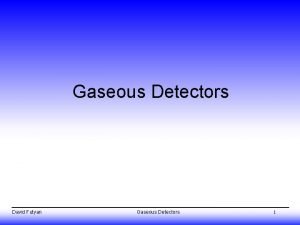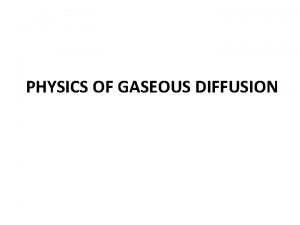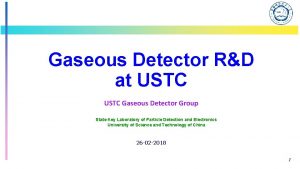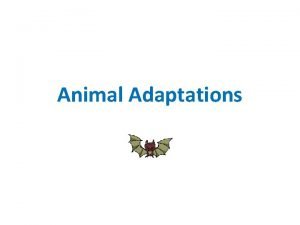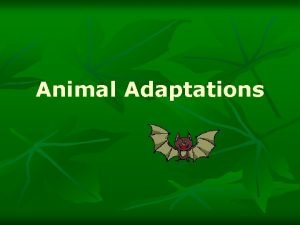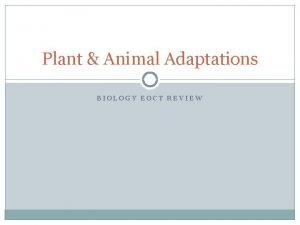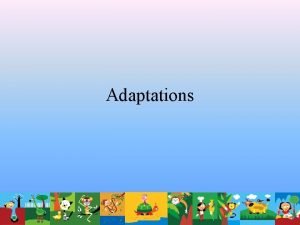Adaptations for Gaseous Exchange The need for gaseous










































































- Slides: 74

Adaptations for Gaseous Exchange The need for gaseous exchange is an essential characteristic for all organisms

http: //en. wikipedia. org/wiki/Amoeba Unicellular Organisms • e. g Amoeba. • Unicellular organism that lives in fresh water. • Maint 700800μm http: //en. wikipedia. org/wiki/Amoeba

Unicellular Organisms • Size less than 1000μm (1 mm) • Simple diffusion accross the cell membrane is sufficient to get oxygen in and carbon dioxide out of the cell. • The Diffusion Pathway is small (less than 0. 5 mm). • The Surface Area : Volume (ratio) is very high due to the size of the organism.

http: //bio 1151. nicerweb. com/Locked/media/lab/limits/ Surface area : Volume

Surface area : Volume Surface area = 3 X 6 = 54 Surface area = 1 X 6 sides = 6 Volume = 3 X 3 = 27 Volume = 1 X 1 = 1 3 1 Surface area : volume = 6 : 1 (=6) 3 Surface area : volume = 54 : 27 = 2 : 1 (=2)

Multicellular organisms • As organisms increase in size, their surface area to volume ratios decrease. • Division of labour exists. • Cells start to become differentiated and become specialised for a particular function.

Becoming Multicellular • Simple organisms sush as Volvox show the start of a body shape. • They are made up of between 1000 and 10, 000 similar cells, thus becoming multicellular. No differentiation yet – all the cells are the same. http: //etc. usf. edu/clipart/5900/5905/volvox_1. htm http: //en. wikipedia. org/wiki/Volvox

Becoming Multicellular • Simple organisms such as Choanoflagellates may be the ancestors of the entire Animal kingdom. http: //en. wikipedia. org/wiki/Choanoflagellates Collar for filtering food Flagellum for movement http: //users. rcn. com/jkimball. ma. ultranet/Biology. Pages/P/Protists. html Er gwybodaeth – nid oes angen dysgu am yr anifeiliaid yma

Multicellular organisms • Many such animals such may have come together to form a COLONY of similar cells, such as the rare freshwater Proterospongia which is a colony of Choanoflagellates. Similar cells are found in the Sponge family belived to be the first multicellular animals. http: //users. rcn. com/jkimball. ma. ultranet/Biology. Pages/P/Protists. html Er gwybodaeth – nid oes angen dysgu am yr anifeiliaid yma

Multicellular organisms • Proterospongia – start of division of labour Collar cells for filtering food Flagellated for movement of colony Amoebic cells in centre divide continuously to increase size of the colony. Er gwybodaeth – nid oes angen dysgu am yr anifeiliaid yma Image from http: //www. gutenberg. org/files/20417 -h/images/image 121 c. jpg

Multicellular organisms development of tissues • • Phylum Cnidaria – Coral, jellyfish & anemones Differentiation and Division of Labour. The development of nerves & muscles. The first animals with a “defined” body. http: //en. wikipedia. org/wiki/Jelly_fish Jelly fish http: //en. wikipedia. org/wiki/Sea_anemones Sea anemones

Multicellular organisms - developing simple systems • Flatworms – first animals to have a brain! • Simple digestive system & simple nervous system with eye spots. http: //universe-review. ca/R 10 -33 -anatomy. htm#flatworms

Developing systems • The animals shown so far have not developed systems for gaseous exchange or for transport (such as blood). • Gaseous exchange – O 2 – CO 2 is carried out over their general body surface in simple organisms. • Larger animals have specialised respiratory (exchange) surfaces.

Exchange surfaces • As organisms increase in size and complexity, they develop systems to exchange substances & develop systems for transporting these substances. # • Characteristics of an efficient surface for gaseous exchage: • Large surface area, thin, moist, permeable surface.

Adaptations for Gaseous Exchange • Small animals such as flatworms exchange gases across their general body surface. • This is due to their SIZE & SHAPE • Being small and flat they have a: • Large Surface area : volume • Short Diffusion Pathway for gases

Surface area : Volume

Adaptations for Gaseous Exchange • The influence of size of organism & environmental conditions influences gaseous exchange. Amoeba are very small (less than 1 mm). They live in fresh or salt water. Diffusion alone is sufficient to meet their needs for gaseous exchange. http: //en. wikipedia. org/wiki/Amoeba

Adaptations for Gaseous Exchange • The influence of size of organism & environmental conditions influences gaseous exchange. Earthworms are slow moving animals that live in a damp, dark environment. They secrete a layer of mucus so as not to dry out. http: //en. wikipedia. org/wiki/Earthworm Diffusion across the skin is sufficient to meet their needs for gaseous exchange.

Adaptations for Gaseous Exchange • Adaptations for gaseous exchange allow an increase in body size. ©HGE http: //en. wikipedia. org/wiki/Ambystoma_mexicanum Internal Gills External Gills Lungs (Internal) http: //commons. wikimedia. org/wiki/File: Lungs_diagram_simple. svg Note: all respiratory surfaces are regions of potential water loss.

Specialised Respiratory Surfaces • Adaptations to environment: • Gills for AQUATIC environments ©HGE http: //en. wikipedia. org/wiki/Ambystoma_mexicanum • Lungs for terrestrial environments These are specialised Systems for gaseous exchange. Diffusion alone across the body’s surface is not sufficient to supply the gaseous needs of the organism. http: //commons. wikimedia. org/wiki/File: Lungs_diagram_simple. svg

Specialised Respiratory Surfaces • The BONY fish - Gills ©HGE • The gills are specialised organs that form a large surface area for gaseous exchange. • They exchange oxygen and carbon dioxide from the water (the respiratory medium). • Water is denser than air with a lower oxygen content. • They are highly vascularised for this purpose (i. e have a large blood supply). • Internal gills help decrease water & heat loss form the blood.

Specialised Respiratory Surfaces http: //commons. wikimedia. org/wiki/File: Lungs_diagram_simple. svg • Internal Lungs (Terrestrial vertebrates) • The lungs are specialised organs that form a large surface area for gaseous exchange. • They exchange oxygen and carbon dioxide from the air (the respiratory medium). • They are highly vascularised for this purpose (i. e have a large blood supply)

Specialised Respiratory Surfaces • The BONY fish – Gills Unidirectional flow of water over the gills Image from http: //images. encarta. msn. com/xrefmedia/aencmed/targets/illus/ilt/T 013965 A. gif

Ventilation Mechanism - Gills • Ventilation mechanism is the physical way of getting the respiratory medium (in this case water) over the respiratory surface (in this case the gills). • As water is denser than air and has a lower oxygen content, bony fish have evolved a highly efficient method of gaseous exchange accross the gills.

Ventilation Mechanism - Gills • Ventilation mechanism in the fish (side view) Inspiration of water Mouth open Operculum closed Floor of buccal cavity lowered Expiration of water ©HGE Mouth closed Floor of buccal cavity raised Operculum open

Ventilation Mechanism - Gills • Ventilation mechanism in the fish ©HGE Inspiration of water (internal view) Expiration of water Buccal cavity Operculum closed Operculum open Water flow over the gills is a continuous prossess

©HGE Ventilation Mechanism - Gills • Inspiration of water Mouth open Low pressure in buccal cavity – water enters Operculum closed Low pressure here – water drawn over gills Floor of buccal cavity lowered

©HGE Ventilation Mechanism - Gills • Expiration of water Mouth closed Higher pressure in buccal cavity – water pushed over the gills Operculum open Higher pressure here – water expelled through operculum Floor of buccal cavity raised

Gaseous exchange - Gills ©HGE • Gill filaments (lamellae) Llun uchod o Examstutor. com

Counter Current flow - Gills • Blood flows in the opposite direction to the flow of water over the gill plate Llun o Examstutor. com

Counter Current flow - Gills • Counter current flow over the gill plate Llun o Examstutor. com

Counter Current flow - Gills • The counter current flow is far more efficient than the parallel flow (e. g sharks) Llun o Examstutor. com

©HGE Counter Current flow v Parallel flow • The counter current flow is far more efficient than the parallel flow (e. g sharks) Blood leaving is nearly as saturated as the water entering Counter flow system As blood flows over the gill plate it meets water which is almost fully saturated with oxygen. This maintains the steep diffusion gradient for gas exchange.

©HGE Counter Current flow v Parallel flow • The counter current flow is far more efficient than the parallel flow (e. g sharks) Blood reaches equilibrium with water Parallel flow system Blood and water are flowing in the same direction over the gill plate. The blood will only manage 50% Oxygen saturation. Diffusion gradient is not maintained.

Amphibians • The frog has a very strange life cycle. • It changes from an embryo to a tadpole and eventually a frog. • The process of change is called metamorphosis. Photo courtesy of the Maryland Department of Natural Resources. www. dnr. maryland. gov

Amphibians - metamorphosis • Firstly the young tadpole develops external gills. • Shortly after they develop internal gills. • Eventually the young frog develops internal lungs. Photo courtesy of the Maryland Department of Natural Resources. www. dnr. maryland. gov

http: //en. wikipedia. org/wiki/Frog Amphibians • The inactive frog uses its moist skin as a respiratory surface. • When active it uses its lungs. http: //users. rcn. com/jkimball. ma. ultranet/Biology. Pages/V/Vertebrate. Lungs. html

Lungs- comparison • The lungs of mammals, birds & reptiles are more efficient than the lungs of amphibians. • Birds have a highly specialised respiratory system to supply the vast amounts of oxygen needed for flight.

Lungs - birds http: //users. rcn. com/jkimball. ma. ultranet/Biology. Pages/V/Vertebrate. Lungs. html Ventilation of the lungs is brought about by movement of the ribcage. Birds do not have a diaphram. During flight, the action of the flight muscles helps to ventilate the lungs. • Birds have evolved a specialised lung structure different to reptiles & mammals. • In addition to the lungs, birds have large air sacs which enables the bird to have oxygenated air in the lungs at all times.

Gaseous exchange - birds • When th bird breathes in, oxygenated air is drawn through the bronchi and through the lungs to the adbominal aer sacs (some passes also into the posterior sacs). • When the bird breathes out, the oxygenated air passes from these air sacs back through the lungs. Dim angen y termau http: //www. earthlife. net/birds/breath. html

Gaseous exchange - birds Don’t need to learn the terms http: //www. earthlife. net/birds/breath. html • When the bird breathes in again, the air this time is drawn through the lungs and into the frontal air sacs. • When air is breathed out this time, it passes out of the system through the bronchus. • There is therefore a constant flow of oxygenated air though the lungs, making this a very efficient system.

Insects – Gaseous exchange • Insects have evolved a very different system for gaseous exchange from other terrestrial animals. http: //www. emc. maricopa. edu/faculty/farabee/BIOBK/Bio. Book. RESPSYS. html • They possess a highly branched system of chitin-lined tubes called tracheae. The tracheae have openings along the side of the insect body called spiracles.

Insects – Gaseous exchange Trachea • Air can be pumped in by expanding the body. • The amount of inspired oxygen is limited with such a system. • This explains why insects don’t grow much more than 10 cm. http: //www. ou. edu/class/invert/spiracle. htm The ends of the tracheae are so fine they can enter individual cells & carry oxygen directly into the cells (such as the muscle cells).

The Respiratory System – the lungs Image from http: //cancerinfo. tri-kobe. org/for_patient/pdq/Media/EN/CDR 0000466533. jpg

The Respiratory System http: //kvhs. nbed. nb. ca/gallant/biology/mammalian_respiratory_system. html

The Respiratory System Cartilage ring The epiglottis is a flap which prevents food & drink from going down the trachea when we swallow. Rings of cartilage around the trachea prevent the trachea from closing http: //www. lung. ca/children/grades 7_12/respiratory_system. html

The Respiratory System Image from http: //www. mesothelioma. uk. com/images/chest%20 wall%20 and%20 pleura. bmp The lungs are surrounded by two pleural membranes with a cavity between them. The cavity is filled with an oily liquid which decreases friction bewteen the lung & the rig cage as the lungs expand & relax.

The Respiratory System http: //www. concept 2. co. uk/training/breathing. php • The rib cage protects the lungs & heart. • Muscles between the ribs help us breathe. • They are called intercostal muscles.

Ventilation mechanism • The rib cage, along with the intercostal muscles and the diaphragm, (strong muscular sheet) bring about the ventilation mechanism (breathing).

Ventilation mechanism Image from http: //myhealth. centrahealth. com/library/healthguide/en-us/images/media/medical/hw/h 5550999_001. jpg • As the THORAX (chest cavity) is air tight- i. e it is sealed by the diaphragm, air can only enter & leave via the trachea. • The coordinated movements of the internal & external intercostal muscles along with the diaphragm brings about the ventilation movements of breathing

Ventilation mechanism Inspiration Expiration http: //www. singintune. org/voice-production. html

Ventilation mechanism • Inspiration • The diaphragm contracts and flattens. • The intercostal muscles contract & lifts the rib cage up and out. http: //www. singintune. org/voice-production. html

Ventilation mechanism • Inspiration • These movements create more room inside thoracic cavity (chest), therefore increasing the volume inside. • The pressure in the thorax decreases below atmospheric pressure & air is drawn IN. http: //www. singintune. org/voice-production. html

Ventilation mechanism • Expiration • The diaphragm relaxes and returns to it’s DOME shape. • The intercostal muscles relax & the rib cage moves back down. http: //www. singintune. org/voice-production. html

Ventilation mechanism • Expiration • These movements create less room inside thoracic cavity (chest), therefore decreasing the volume inside. • The pressure in the thorax increases above atmospheric pressure & air is pushed OUT. http: //www. singintune. org/voice-production. html

Gaseous exchange – the alveoli • The ventilation mechanism causes air to be drawn in and pushed out of the lungs. • This bring the respiratory medium (in our case AIR) into contact with the respiratory surfaces (alveoli) where gas exchange takes place. • Human lungs contain approx 300 million alveoli giving a surface area for gas exchange in the region of 70 -90 m 2

Gaseous exchange – the alveoli • Gaseous exchange takes place in the ALVEOLI (sing. Alveolus) Branch of the pulmonary vein (carrying oxygenated blood back to heart) bronchiole Capillary network (surrounds each alveolus) Image from http: //www. biology. arizona. edu/chh/problem_sets/lung_toxicology/graphics/smalveoli. gif Branch of the pulmonary artery (carrying deoxygenated blood from heart) alveolus

Image from http: //www. biology. arizona. edu/chh/problem_sets/lung_toxicology/graphics/smalveoli. gif

Gaseous exchange • Table to show percentage of gases found in the air. • These can also be shown as partial pressures. Inspired air Alveolar air Expired air Oxygen 20. 95% 13. 80% 16. 40% Carbon dioxide Nitrogen 0. 04% 5. 50% 4. 00% 79. 01% 80. 70% 79. 60%

Gaseous exchange in Plants • The angiosperm leaf. Image from http: //www. bio. umass. edu/biology/conn. river/misc_images/photosyn 1. jpg

Gaseous exchange - The Leaf • The angiosperm leaf – Privet ts. http: //www 2. eou. edu/~kantell/img 0007. jpg

Gaseous exchange - The Leaf Vascular bundle http: //www. emc. maricopa. edu/faculty/farabee/BIOBK/Bio. Book. PS. html

Gaseous exchange - The Leaf • The angiosperm leaf – transverse section (ts). Learn ! http: //schools-wikipedia. org/2006/wp/l/Leaf. htm

Gaseous exchange - The Leaf • Leaf structure – privet ts http: //www. lima. ohio-state. edu/academics/biology/images/ligust 2. jpg http: //www. lima. ohio-state. edu/academics/biology/images/ligust 1. jpg

Gaseous exchange - The Leaf • Stomata (singular = stoma) Close up of lower epidermis Stoma = pore Guard cell http: //www. freewebs. com/jdingfel/stomata. htm

Gaseous exchange - The Leaf • Gaseous exchange occurs through the stomata (which open during the day and normally close at night). • A diffusion gradient occurs from the atmosphere to the inside of the leaf. • CO 2 required during the day for photosynthesis diffuses into the leaf. • The sub-stomatal air chamber helps to maintain this diffusion gradient into the leaf.

Gaseous exchange - The Leaf • Gaseous exchange in the leaf The CO 2 diffuses from the sub-stomatal air chamber through the spongy mesophyll cells (lots of air spaces) to the palisade cells – the site of photosynthesis in the leaf. As the stomata are open during the day, the plant also loses water through the stomata. http: //extension. oregonstate. edu/mg/botany/photo 2. html

Stomata – opening & closing • Stomata open during the day (light) & close at night (dark). • There are different theories for how stomata open & close. • The most widely trusted theory involves the active uptake of potassium ions into the guard cells.

Stomata – opening & closing Image from http: //biology. uwsp. edu/faculty/ESingsaa/reference/lecture 6/gcellvol. htm Guard cell Stoma (pore) Thickened inner wall (thicker than outer wall) and is therefore less flexible

Stomata – opening & closing Stoma open Turgid guard cells – high internal pressure causes pore to open. Image from http: //biology. uwsp. edu/faculty/ESingsaa/reference/lecture 6/gcellvol. htm Stoma closed Flaccid guard cells – pressure inside cells drop – pore closes.

Stomata – opening Potassium ions Turgid Guaed cell Vacuole full of water Stoma open Image from http: //biology. uwsp. edu/faculty/ESingsaa/reference/lecture 6/gcellvol. htm Potassium ions are actively pumped into the guard cells from the surrounding cells. Active transport of K+ requires energy from ATP Accumulation of K+ lowers the water potential (negative Ψ) of the guard cells and water follows in by osmosis. The vacuoles fill up & the cells become turgid – pore opens.

Stomata – closing Flaccid Guard cell Stoma closed Image from http: //biology. uwsp. edu/faculty/ESingsaa/reference/lecture 6/gcellvol. htm Potassium ions escape from the guard cells. Outflow of K+ means the water potential becomes less negative (Ψ), water leaves the cells by osmosis. The vacuoles lose water cells become flaccid – pore closes.

Xerophytic plants • Xero = dry phyte = plant • Xerophytes are plants which are able to survive in an ecosystem with little available water. Marram grass is an example of a xerophytic plant (xerophyte). http: //en. wikipedia. org/wiki/Marram_grass Marram grass lives in sand dunes where water is rarely available.

http: //www. bbc. co. uk/scotland/education/bitesize/higher/biology/genetics_adaptation/transpiration 2_rev. shtml Xerophytic plants • Xerophytes are adapted to dry conditions The leaves of marram grass are specially adapted to prevent water loss. One of the main adaptations of xerophytic plants is that they can close their stomata during the day and open them at night. Marram grass have leaves which can roll up, a thick cuticle, stomata sunken in pits inside the leaf and many hair cells.
 Gaseous exchange grade 11 practical
Gaseous exchange grade 11 practical Gaseous exchange in protozoa
Gaseous exchange in protozoa Pearson
Pearson Gaseous exchange in grasshopper
Gaseous exchange in grasshopper Gaseous exchange in animals
Gaseous exchange in animals Gas exchange key events in gas exchange
Gas exchange key events in gas exchange Addison currency exchange
Addison currency exchange Voluntary exchange
Voluntary exchange Inorganic gaseous pollutants of air
Inorganic gaseous pollutants of air Non gaseous alkalosis
Non gaseous alkalosis Gaseous equilibrium
Gaseous equilibrium Gaseous state chapter
Gaseous state chapter Gaseous dosage form examples
Gaseous dosage form examples My very excited mother planets
My very excited mother planets Granular porosity denture
Granular porosity denture Gaseous envelope of the sun
Gaseous envelope of the sun At 500 k one mole of gaseous oncl
At 500 k one mole of gaseous oncl Inorganic gaseous pollutants of air
Inorganic gaseous pollutants of air Gaseous dosage form
Gaseous dosage form Gaseous solution
Gaseous solution Dạng đột biến một nhiễm là
Dạng đột biến một nhiễm là Biện pháp chống mỏi cơ
Biện pháp chống mỏi cơ độ dài liên kết
độ dài liên kết Voi kéo gỗ như thế nào
Voi kéo gỗ như thế nào Thiếu nhi thế giới liên hoan
Thiếu nhi thế giới liên hoan điện thế nghỉ
điện thế nghỉ Một số thể thơ truyền thống
Một số thể thơ truyền thống Thế nào là hệ số cao nhất
Thế nào là hệ số cao nhất Trời xanh đây là của chúng ta thể thơ
Trời xanh đây là của chúng ta thể thơ Lp html
Lp html Sơ đồ cơ thể người
Sơ đồ cơ thể người Các số nguyên tố
Các số nguyên tố đặc điểm cơ thể của người tối cổ
đặc điểm cơ thể của người tối cổ Tia chieu sa te
Tia chieu sa te Các châu lục và đại dương trên thế giới
Các châu lục và đại dương trên thế giới Tư thế worm breton là gì
Tư thế worm breton là gì ưu thế lai là gì
ưu thế lai là gì Tư thế ngồi viết
Tư thế ngồi viết Bàn tay mà dây bẩn
Bàn tay mà dây bẩn Cách giải mật thư tọa độ
Cách giải mật thư tọa độ Các châu lục và đại dương trên thế giới
Các châu lục và đại dương trên thế giới Bổ thể
Bổ thể Tư thế ngồi viết
Tư thế ngồi viết Thẻ vin
Thẻ vin Giọng cùng tên là
Giọng cùng tên là Thơ thất ngôn tứ tuyệt đường luật
Thơ thất ngôn tứ tuyệt đường luật Chúa sống lại
Chúa sống lại Từ ngữ thể hiện lòng nhân hậu
Từ ngữ thể hiện lòng nhân hậu Khi nào hổ con có thể sống độc lập
Khi nào hổ con có thể sống độc lập Diễn thế sinh thái là
Diễn thế sinh thái là Vẽ hình chiếu vuông góc của vật thể sau
Vẽ hình chiếu vuông góc của vật thể sau Làm thế nào để 102-1=99
Làm thế nào để 102-1=99 Tỉ lệ cơ thể trẻ em
Tỉ lệ cơ thể trẻ em Lời thề hippocrates
Lời thề hippocrates đại từ thay thế
đại từ thay thế Vẽ hình chiếu đứng bằng cạnh của vật thể
Vẽ hình chiếu đứng bằng cạnh của vật thể Quá trình desamine hóa có thể tạo ra
Quá trình desamine hóa có thể tạo ra Các môn thể thao bắt đầu bằng tiếng đua
Các môn thể thao bắt đầu bằng tiếng đua Công của trọng lực
Công của trọng lực Thế nào là mạng điện lắp đặt kiểu nổi
Thế nào là mạng điện lắp đặt kiểu nổi Hát kết hợp bộ gõ cơ thể
Hát kết hợp bộ gõ cơ thể Khi nào hổ con có thể sống độc lập
Khi nào hổ con có thể sống độc lập Mat för unga idrottare
Mat för unga idrottare Smärtskolan kunskap för livet
Smärtskolan kunskap för livet Bris för vuxna
Bris för vuxna Vad är ett minoritetsspråk
Vad är ett minoritetsspråk Trög för kemist
Trög för kemist Delegerande ledarstil
Delegerande ledarstil Ellika andolf
Ellika andolf Datorkunskap för nybörjare
Datorkunskap för nybörjare Toppslätskivling effekt
Toppslätskivling effekt Ekologiskt fotavtryck
Ekologiskt fotavtryck Steg för steg rita
Steg för steg rita Redogör för vad psykologi är
Redogör för vad psykologi är Ramsa geometriska former
Ramsa geometriska former
